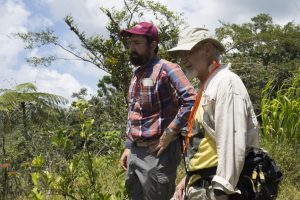Can a tiny invasive snail help save Latin American coffee?
By University of Michigan
1/23/2020

In this July 2018 photo, U-M doctoral student Zachary Hajian-Forooshani and U-M ecologist John Vandermeer survey a Puerto Rican coffee farm damaged less than a year earlier by Hurricane Maria. Image credit: Levi Stroud, University of Michigan
ANN ARBOR—While conducting fieldwork in Puerto Rico’s central mountainous region in 2016, University of Michigan ecologists noticed tiny trails of bright orange snail excrement on the undersurface of coffee leaves afflicted with coffee leaf rust, the crop’s most economically important pest.
Intrigued, they conducted field observations and laboratory experiments over the next several years and showed that the widespread invasive snail Bradybaena similaris, commonly known as the Asian tramp snail and normally a plant-eater, had shifted its diet to consume the fungal pathogen that causes coffee leaf rust, which has ravaged coffee plantations across Latin America in recent years.
Now the U-M researchers are exploring the possibility that B. similaris and other snails and slugs, which are part of a large class of animals called gastropods, could be used as a biological control to help rein in coffee leaf rust. But as ecologists, they are keenly aware of the many disastrous attempts at biological control of pests in the past.
“This is the first time that any gastropod has been described as consuming this pathogen, and this finding may potentially have implications for controlling it in Puerto Rico,” said U-M doctoral student Zachary Hajian-Forooshani, lead author of a paper published online Jan. 12 in the journal Ecology.
“But further work is needed to understand the potential tradeoffs B. similaris and other gastropods may provide to coffee agroecosystems, given our understanding of other elements within the system,” said Hajian-Forooshani, who is advised by U-M ecologist John Vandermeer, a professor in the Department of Ecology and Evolutionary Biology.
Vandermeer and U-M ecologist Ivette Perfecto, a professor at the School for Environment and Sustainability, lead a team that has been monitoring coffee leaf rust and its community of natural enemies on 25 farms throughout Puerto Rico’s coffee-producing region.
Those natural enemies include fly larvae, mites, and a surprisingly diverse community of fungi living on coffee leaves, within or alongside the orange blotches that mark coffee leaf rust lesions. Hajian-Forooshani has been studying all of these natural enemies for his doctoral dissertation.
“Of all the natural enemies I have been studying, these gastropods in Puerto Rico most obviously and effectively clear the leaves of the coffee leaf rust fungal spores,” he said in an email from Puerto Rico.
Read more here: https://news.umich.edu/can-a-tiny-invasive-snail-help-save-latin-american-coffee/
Read the article in Ecology: https://esajournals.onlinelibrary.wiley.com/doi/abs/10.1002/ecy.2966